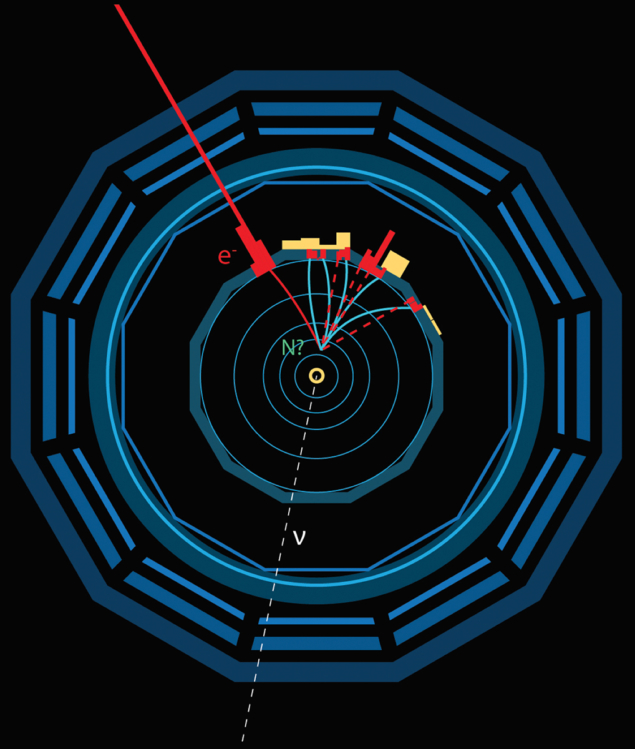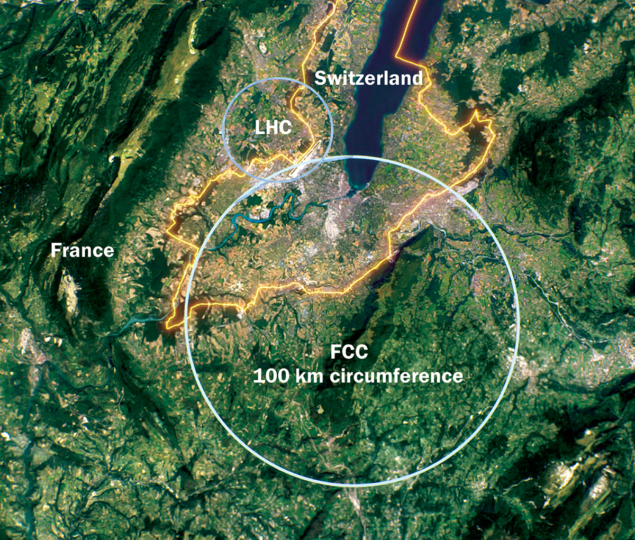A 100 km tunnel hosting a circular electron–positron collider as a first stage towards a 100 TeV proton–proton collider would probe new phenomena coupled to the Higgs and electroweak sectors with unparalleled precision.

The proposed 100 km-circumference Future Circular Collider (FCC) at CERN features, as a first stage, an electron–positron Higgs and electroweak factory (FCC-ee) operating at centre-of-mass energies from 91 GeV (the Z mass) to a maximum of 365 GeV (above the tt production threshold). The same tunnel is then planned to host a hadron collider (FCC-hh) operating at the highest possible energies, at least 100 TeV. The complete FCC programme, whose financial and technical feasibility is currently under study, offers unprecedented potential in terms of the reach on phenomena beyond the Standard Model (SM). The proposed Circular Electron Positron Collider project in China adopts the scheme envisioned for the FCC-ee, with a somewhat less ambitious overall physics programme.
While the original goal of a future lepton collider is the precise study of the interactions of the scalar boson discovered in 2012 at the LHC, seeking answers to open questions in particle physics requires many high-precision measurements of the other three heaviest SM particles: the W and Z electroweak bosons and the top quark. Beyond the exploration of the Higgs sector, FCC-ee offers a rich range of opportunities to indirectly and directly discover new phenomena.
Studies of Higgs-boson interactions are prime tests of the dynamics of electroweak symmetry breaking and of the generation of elementary-particle masses. At FCC-ee, the Higgs boson will dominantly be produced by radiation off a Z boson. With around one million such e+e– → ZH events recorded in three years of operation, a per-mil precision is targeted on the cross-section measurement. This corresponds to probing phenomena coupled to the scalar SM sector at energy scales approaching 10 TeV. The Higgsstrahlung process is, however, sensitive to gauge interactions beyond those of the Higgs boson (see “Higgs production” figure), which can themselves be affected by new physics. A robust test of the SM’s consistency will require independent experimental determination of these interactions. The precision available today is insufficient, however, and calls for new electroweak measurements to be performed.
Electroweak and top-quark precision
FCC-ee will provide these missing pieces, and much more. An unprecedented number (5 × 1012) of Z bosons will be produced with an exquisite knowledge of the centre-of-mass energy (100 keV or lower, thanks to the availability of transverse polarisation of the beams), thereby surpassing the precision of all previous measurements at LEP and SLC by several orders of magnitude. Uncertainties of the order of 100 keV on the Z-boson’s mass and 25 keV on its width can be achieved, as well as precisions of around 10–5 on the various charged fermion couplings, and of 3 × 10–5 on the QED coupling strength αQED (mZ). Impressive numbers of pairs of tau leptons (1.7 × 1011) and 1012 each of c and b quarks will be produced in Z decays, allowing order-of-magnitude improvements on tau and heavy-flavour observables compared to other planned facilities.

At the WW threshold, with 108 W bosons collected at a centre-of-mass energy of 161 GeV and threshold scans with an energy uncertainty of about 300 keV, a unique W-boson mass precision of 0.5 MeV will be reached. Meticulous measurements of di-boson production will be essential for the Higgs programme, given the gauge-symmetry relations between triple-gauge-boson and Higgs-gauge-boson interactions. Hadronic W and Z decays will also provide measurements of the QCD coupling strength with per-mil uncertainties – a factor of 10 better than the current world average.
Stepping up to a centre-of-mass energy of 350 GeV, e+e– → tt measurements would deliver an impressive determination of the top-quark mass with 10 MeV statistical uncertainty, thanks to energy scans with a 4 MeV precision. At the highest FCC-ee energies, the determination of the top quark’s electroweak couplings, which affect Higgs processes, can be performed to sub-percent precision.
These high-precision FCC-ee measurements in the Higgs, electroweak and top-quark sectors will be sensitive to a large variety of new-physics scenarios. High-mass physics with SM couplings, for example, can be tested up to scales of the order of 50 TeV. Regardless of mass scale, mixing of new particles with known ones at the level of a few tens of ppm will also produce visible effects.
Probing new physics at the Z pole
Given that new light particles are constrained to be feebly coupled to the SM, large e+e– luminosities are needed to search for them. By examining an astounding number of Z-boson decays, FCC-ee will explore uncharted territories in direct searches for feebly coupled light states, such as heavy neutral leptons and axion-like particles. If not directly produced, the former are also probed indirectly through precision electroweak measurements.

Heavy neutral leptons (N) are sterile particles, such as those invoked in neutrino mass-generation mechanisms. The mixing of these states with neutrinos would induce interactions with electroweak bosons and charged leptons, for example N¯W, NνZ or NνH. Heavy neutral leptons can have a wide range of masses and be searched for at FCC-ee, both directly and indirectly, with unparalleled reach. When heavier than the muon and mixing with either the e or µ flavours, they lower the µ → eνeνµ decay rate and affect the extraction of the Fermi constant, leading to deviations from the SM in many precision electroweak observables. When lighter than the Z boson, they could be produced in Z → νN decays. FCC-ee will bring order-of-magnitude improvements over LEP bounds in both regimes (see “Heavy neutral leptons” figure). The direct sensitivity improves even more dramatically than the indirect one: in the parameter space where N have sizeable lifetimes, displaced vertices provide a spectacular, background-free, signature (see “Discovery potential” image). This region of great interest corresponds to weak-scale leptogenesis, in which right-handed neutrinos participate in the generation of the baryon asymmetry of the universe.

Axion-like particles (ALPs) are pseudoscalar singlets with derivative couplings to the SM, which may be generated in the breaking of global symmetries at high scales. They could contribute to the dark-matter relic abundance and, in a specific range of parameter space, provide a dynamical explanation for the absence of CP violation in the strong interaction. Having symmetry-protected masses, ALPs can be naturally light. For masses smaller than twice that of the electron, they can only visibly decay to photons. Suppressed by a potentially large scale, their couplings to the SM may be tiny. ALPs lifetimes could thus be large. A coupling to either hypercharge or weak isospin would allow them to be produced in Z-boson decays together with a photon and to decay to photon pairs. Searching for this signature, FCC-ee will probe couplings more than an order of magnitude smaller than those accessible at the LHC (see “Axion-like particles” figure). Pairs of ALPs could possibly also be produced in the decay of the Higgs boson, whose small width enhances branching fractions and allows small couplings to be probed. Producing Higgs bosons in larger numbers, hadron colliders are, however, more efficient at probing such interactions.
Towards a new frontier
The physics potential of FCC-ee clearly extends much beyond its original purpose as a Higgs and electroweak factory. Upgrading the facility to FCC-hh will require a new machine based on high-field superconducting magnets, although key parts of FCC-ee infrastructure would be usable at both colliders. Compared to the LHC, FCC-hh will collect about 10 times more integrated luminosity and increase the direct discovery reach for high-mass particles – such as Z′ or W′ gauge bosons, gluinos and squarks, and even WIMP dark matter – by a factor of around 10, up to scales of about 50 TeV. It would also serve as a giga Higgs factory, producing more than 1010 Higgs bosons during its planned 25 years of data taking, albeit not in the ultraclean collision environment of FCC-ee.

Beyond exquisite precision on Higgs-boson couplings to other SM particles, a 100 TeV proton–proton collider comes to the fore in revealing how the Higgs boson couples to itself, which is connected to the electroweak phase transition in the early universe and ultimately to the stability of the vacuum. The rate of Higgs pair-production events, which in some part occur through the Higgs self-interaction, would grow by a factor of 40 at FCC-hh with respect to the LHC and enable this unique property of the Higgs boson to be measured with a statistical accuracy reaching ±2%. Such a measurement would comprehensively explore classes of models that rely on modifying the Higgs potential to drive a strong first-order phase transition at the time of electroweak symmetry breaking, a necessary condition to induce baryogenesis.
Stepping up to an energy of 350 GeV would deliver an impressive determination of the top-quark mass
Following the highly successful model of LEP and its successor, the LHC, the integrated FCC programme offers a far-reaching particle-physics programme at the limits of known technology to significantly push the frontier of our knowledge of the fundamental particles and interactions. A conceptual design report was published in 2019, estimating that operations could begin as soon as 2040 for FCC-ee and 2065 for FCC-hh. Exploring the financial and technical feasibility of this visionary project
is one of the highest priority recommendations of the 2020 update of the European strategy for particle physics, with a decision on whether or not to proceed expected by the next strategy update towards the middle of the decade.
Further reading
S Antusch and O Fischer 2015 JHEP 05 053.
M Bauer et al. 2019 Eur. Phys. J. C 79 74.
J de Blas et al. 2019 JHEP 12 117.
G Durieux et al. 2018 Chin. Phys. C 42 123107
FCC Collaboration 2019 Eur. Phys. J. C 79 474.








